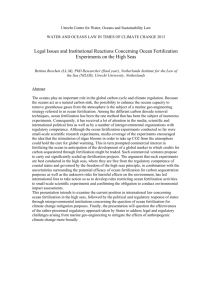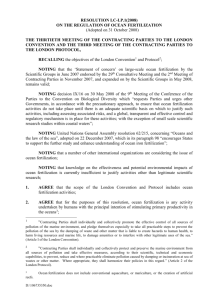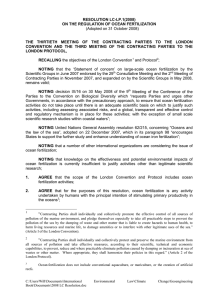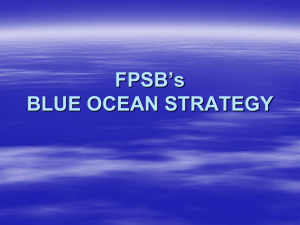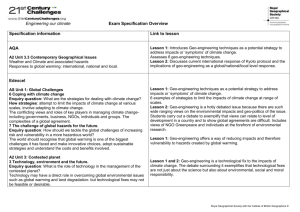Ocean Fertilization - Utrecht Centre for Water, Oceans and
advertisement
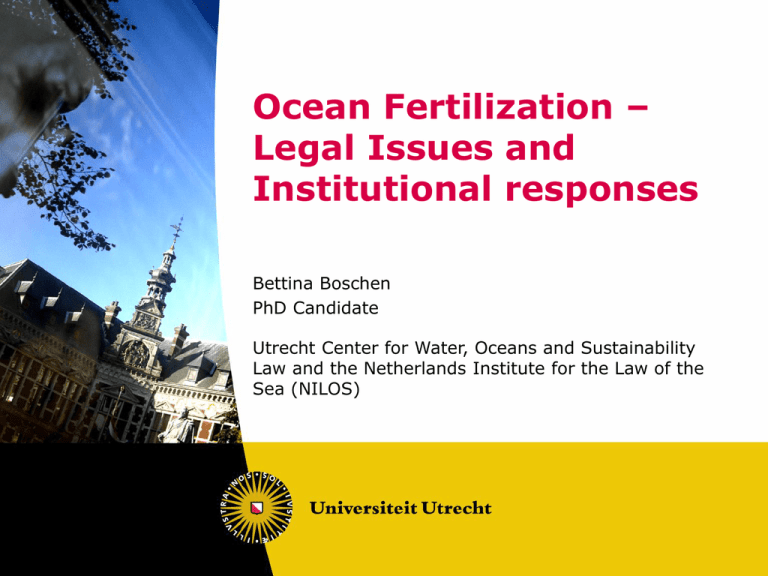
Ocean Fertilization – Legal Issues and Institutional responses Bettina Boschen PhD Candidate Utrecht Center for Water, Oceans and Sustainability Law and the Netherlands Institute for the Law of the Sea (NILOS) Overview • About Ocean Fertilization – From scientific experiments to geo-engineering strategy • International law and Ocean Fertilization – – – Law of the Sea International Environmental Legal Principles Relevant treaty regimes • Institutional Responses – – Finding a suitable forum 1972 London Convention and its 1996 Protocol on the Prevention of Marine Pollution • Assessment / Conclusions About Ocean Fertilization • Scientific research experiments on basis of suggestion that the introduction of certain nutrients, or iron, will stimulate growth of plankton • Ocean iron enrichment experiments result in algal blooms • Role of photsynthesisers in the carbon cycle and the natural function of oceans as a carbon sink • Assuming that algal blooms can be controlled, ocean fertilization as a geo-engineering (CDR) strategy Ocean fertilization as a geoengineering strategy Definition geo-engineering: “the deliberate large-scale manipulation of the planetary environment to counteract anthropogenic climate change” (2009 Royal Society Report) Methods: – Carbon Dioxide Removal (CDR) – Solar Radiation Management (SRM) Marine Geo-engineering: – E.g. Ocean Fertilization (CDR) – E.g. ‘Cloud Whitening’ or ‘Water Brightening’ (SRM) Ocean Fertilization Experiments in the High Seas • 12 small scale research experiments between 1993 – 2005 • 2006 Planktos Corp. plans to conduct OF near Galapagos islands • 2007 Ocean Nourishment proposal to conduct OF in Sulu sear / Philipines • 2009 LOHAFEX experiment (Germany/India) • 2012 Canada / Haida ocean fertilization incident Ocean Fertilization Experiments in the High Seas Source: Boyd et al. (2007) ‘ Mesoscale Iron Enrichment Experiments’ Science Vol. 315, p. 612, International Legal Framework The Law of the Sea • 1982 UN Convention on the Law of the Sea – Constitution for the Oceans (LOSC) – Jurisdictional and substantive framework for the Oceans • Activities taking place in maritime zones beyond national jurisdiction: • Part VII “High Seas”, Article 87 freedom of scientific research • Part XII “Protection and preservation of the marine environment” • Part XIII “Marine Scientific Research” • LOSC refers to ‘competent organizations’ to regulate / develop more specific rules International Legal Framework International Environmental Legal Principles • Principles – Obligation to prevent harm – Obligation to prevent pollution – Application of the precautionary principle – Obligations to cooperate, exchange information and conduct EIAs • Limits of these principles – Allow for broad interpretation – No specific regulatory framework International Legal Framework – Relevant Treaty Regimes • CBD – CBD objective is the conservation of biodiversity – Jurisdictional scope includes coastal areas and activities taking place in the high seas. • UNFCCC and Kyoto Protocol – Climate Change regime but doesn’t cover geoengineering – Carbon credits for reduction emissions (at source) not through geo-engineering (except perhaps forestation) • Antarctic Treaty System – 1991 Protocol on Environmental Protection • OSPAR Convention Institutional Responses – Which Forum? Scientific Technical Reports – UNESCO/IOC ad hoc Consultative Group on Ocean Fertilization – CBD (Convention on Biological Diversity) Subsidiary Body on Scientific, Technical and Technological Advice – SCOR & GESAMP (Scientific Committee on Oceanic Research and Joint Group of Experts on the Scientific Aspects of Marine Environmental Protection) – London Convention and Protocol Scientific Groups – UNEP World Conservation Monitoring Centre – IPCC (Intergovernmental Panel on Climate Change). Institutional Responses – Which Forum? Policy / Political responses – 2007 London Convention/Protocol “Statement of Concern” – 2008 CBD COP Decision IX/16 – 2008 London Convention/Protocol “Resolution1” – 2010 CBD COP Decision X/29 – 2010 London Convention/Protocol “Resolution2” – 2007 - 2012 UNGA Annual Resolution on the Law of the Sea and Ocean Affairs Legal Response – London Convention/Protocol Legal Responses – 2008 London Convention/Protocol “Resolution1” • • • • scope includes ocean fertilization only legitimate scientific research should be allowed case-by case assessment using an assessment framework If not then contrary to the aims of the Convention – 2010 London Convention/Protocol “Resolution2” • Adoption of Assessment Framework for Scientific Research Involving Ocean Fertilization’ – 2013 London Protocol amendment Legal Response – London Convention/Protocol 2013 London Protocol amendment – New Art 6b “Contracting Parties shall not allow the placement of matter into the sea [ … ] for marine geo-engineering activities listed in Annex 4, unless the listing provides that the activity or the sub-category of an activity may be authorized under a permit” – New Annex 4 to the Protocol • Ocean fertilization as defined in the Annex may only be considered for a permit if it is assessed as constituting legitimate scientific research taking into account any specific placement assessment framework. – New Annex 5 to the Protocol • Assessment Framework Conclusions • Decentralized nature of current international legal and institutional framework presents significant challenge for the regulation of geo-engineering activities. • Rapid response through London Convention/Protocol to address ocean fertilization but ad hoc approach to regulation of geo-engineering. • Missing policy discussion on the role of geo-engineering methods and the mitigation of the effects of anthropogenic climate change. • Suggestion to include the geo-engineering discussion within the UNFCCC framework as the appropriate forum to develop general principles governing geo-engineering.
